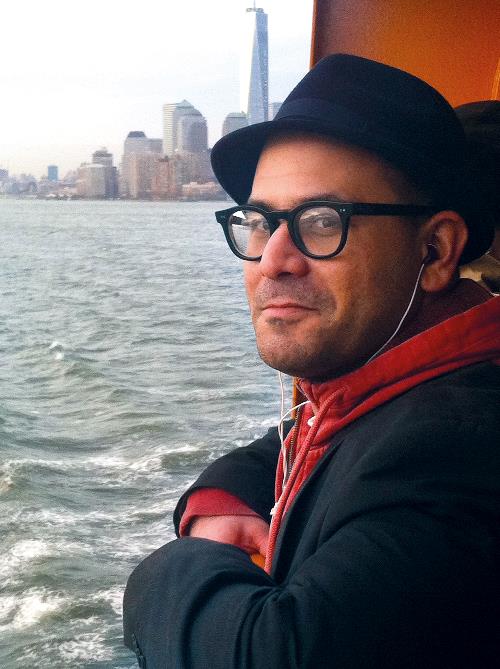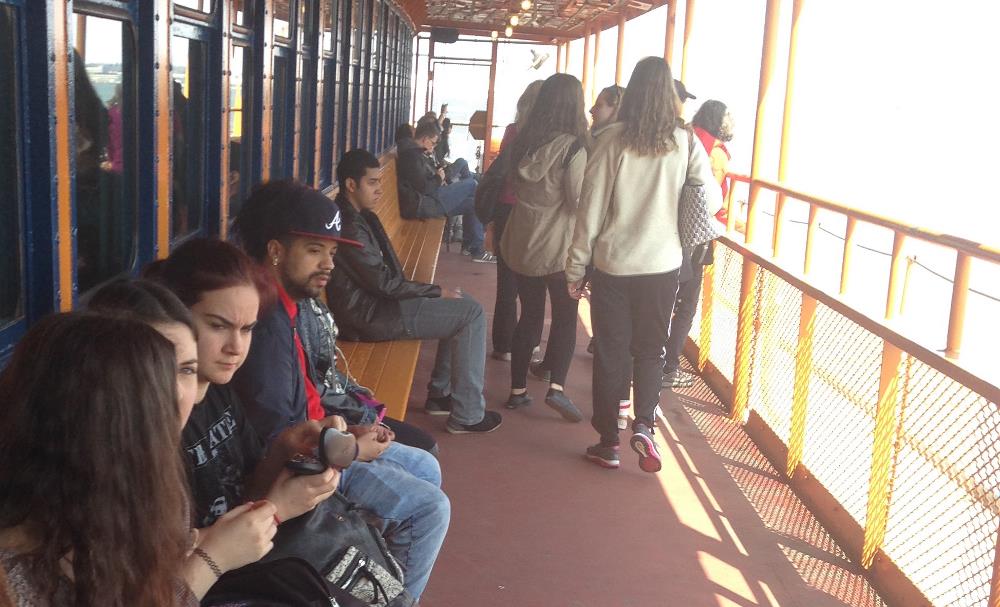CHALLENGE
To expand on the idea of “podplays” and make them more accessible.
PLAN
Make the text less narrator-heavy and more narrative-driven; visit the site a number of times; make the play downloadable and self-scheduled.
WHAT WORKED
Performances are different at different times of day; there’s less time commitment than for a traditional play; the concept attracts diverse audiences.
WHAT DIDN’T
Timing the text to the length of a ferry ride proved tricky; marketing language needs to be specific to battle preconceived notions.
WHAT’S NEXT
More plays for the smartphone set.
Director Erin B. Mee first heard about podplays a few years ago when she was teaching a theatre course. After one of her students told her about a cheeky podcast play from Vancouver, Mee became intrigued by the concept of downloading a recorded text onto one’s electronic device—be it the short-lived and now virtually extinct iPod or the currently more ubiquitous smartphone—and began to keep track of such productions.
“I noticed that most podplays were a combination of a recorded podcast and some kind of live theatrical event, usually where you go on a certain walk at a specific time,” Mee observes. Nevertheless, she found herself often taken out of the podplay action by narrators directing you to look at a certain thing or asking you to perform a certain task. “Podplays often made me feel like I was on a museum tour rather than being in a play,” she says.
Mee, who is based in New York City, began talking with a playwright collaborator, Jessie Bear, about making a play that would be self-guided, in which the audience could steer themselves instead of having to show up somewhere at a certain time and follow instructions. At the time, Bear and Mee (who together comprise This Is Not a Theatre Company) were working on Pool Play, a site-specific play set in a swimming pool. As they considered potential podplay locations, the pair ultimately decided that, rather than a pool, the Staten Island Ferry would be a wonderfully rich setting for a self-guided aural endeavor. Enter Ferry Play.
“We rode the ferry a bunch of times, and we began to look around and think about everyone on the ferry as a character,” Mee reports. Bits of conversations Mee and Bear overheard provided inspiration for scenes in Ferry Play, such as one salty exchange between two men about sobering up. Another snippet of text comes from a teenage girl telling listeners to “look at that creepy guy over there.”
Such borrowed dialogue can have varied effects. “If you hear the teenage character, April, mention a ‘creepy guy’ and you happen to see someone who seems creepy, then you agree with her,” Mee reasons, “but if you see someone who doesn’t seem creepy, then you might think April is being overly judgmental. And if there’s no one there, you might suspect that she’s making some kind of practical joke.”
To further enrich the complexity, Mee points out that the ever-changing surroundings of the ferry—the passengers, the water, the skyline—prompt audiences to connect with the show in individual ways and have a one-of-a-kind experience. “You think because the play is on a smartphone that it’s going to be tech-focused, but actually we ask you to ignore the technology and engage with the environment,” she says.

During Act 1 of Ferry Play, passengers travel from Manhattan to Staten Island. Act 2 is the return trip. “It’s the first podplay, to my knowledge, that has multiple acts,” Mee notes. Audiences can return immediately after Act 1 or have dinner on Staten Island and listen to Act 2 on the ride back. If you’re a commuter living on Staten Island, you might listen to Act 2 the following morning.
As Mee and Bear plotted out Ferry Play, they realized that Act 1 would need to adhere to the 18-and-a-half-minute length of the trip—they didn’t want extra chatter because they thought audiences might turn off the play once they’d gotten off the boat. Limiting Act 1 to that strict time frame happened organically, but sculpting Act 2 was trickier. At first it was too short, then it was too long. “We also had to figure out just when people should press the play button,” says Mee, who points out that boarding announcements happen at various times on the ferry; she and Bear eventually decided that audiences should hit “play” as soon as the boat begins to move.
Mee and Bear gathered a gaggle of actors to make a scratch recording, so they could learn more about the show by listening to it on ferry trial runs. “We also worked with an incredible sound designer, who suggested that the recording be binaural—that you hear some things in the left ear and some in the right ear, like how you would process sound in real life,” Mee elaborates.
The scratch recording proved useful. Bear did some rewrites. A second round of actors was gathered and another scratch recording helped them adjust their techniques. “Most of the actors were off book when we did the final recording—except for Tom Nelis, because we kept changing one of his monologues,” Mee recounts. Perhaps surprisingly, Mee and her team blocked out the recording: “Our sound designer walked between the actors to pick up their voices, much as one would hear dialogue on the actual ferry,” she explains.
Mee estimates that Ferry Play cost somewhere between $5,000 and $6,000, which is a typical budget for This Is Not a Theatre Company. Actors were paid and sound equipment was rented, but the biggest cost was the fee for the app designer, which Mee says came at a steep discount. Nevertheless, downloading Ferry Play costs a mere $1.99. “I wanted it to be about the same price as any other app,” says Mee.
And a great thing about a downloadable play for $1.99 is that it attracts an incredibly mixed audience. “We handed out flyers to promote the show, and we had people of all ages, ethnic backgrounds and job descriptions who were interested—people with strollers, people in suits, people in scrubs. You name it.”
Another perk of a podplay is that the show goes on in perpetuity. Mee is hopeful that in a year the company will recoup its losses; and if people keep downloading Ferry Play for years to come, the group could even make a profit.
Still, a bitterly cold winter and slow spring thaw has created a challenge in promoting the show, and the language of theatre hasn’t quite caught up to the marketing of a podplay. “People are confused when we say that it’s self-guided—they want to know when and where they need to be to see the show,” Mee concedes. “There’s a cognitive framework that we’re used to when it comes to talking about plays, so our marketing has tried to challenge that.”
Marketing challenges aside, Mee is optimistic about what a podplay can do. “As a director, I get to see it as many times as I like. There are so many iterations—the ferry is incredibly different at sunset than it is at 11 a.m. on a Sunday.” For others keen on making a moveable play, Mee recommends concentrating on how to make the recording a play as opposed to a tour. Layering together the sounds of the site and the recording are one key to success. But most of all Mee insists on knowing your site super well. “Visit it during different times of day and in different seasons,” she says. “Know its moods.”


